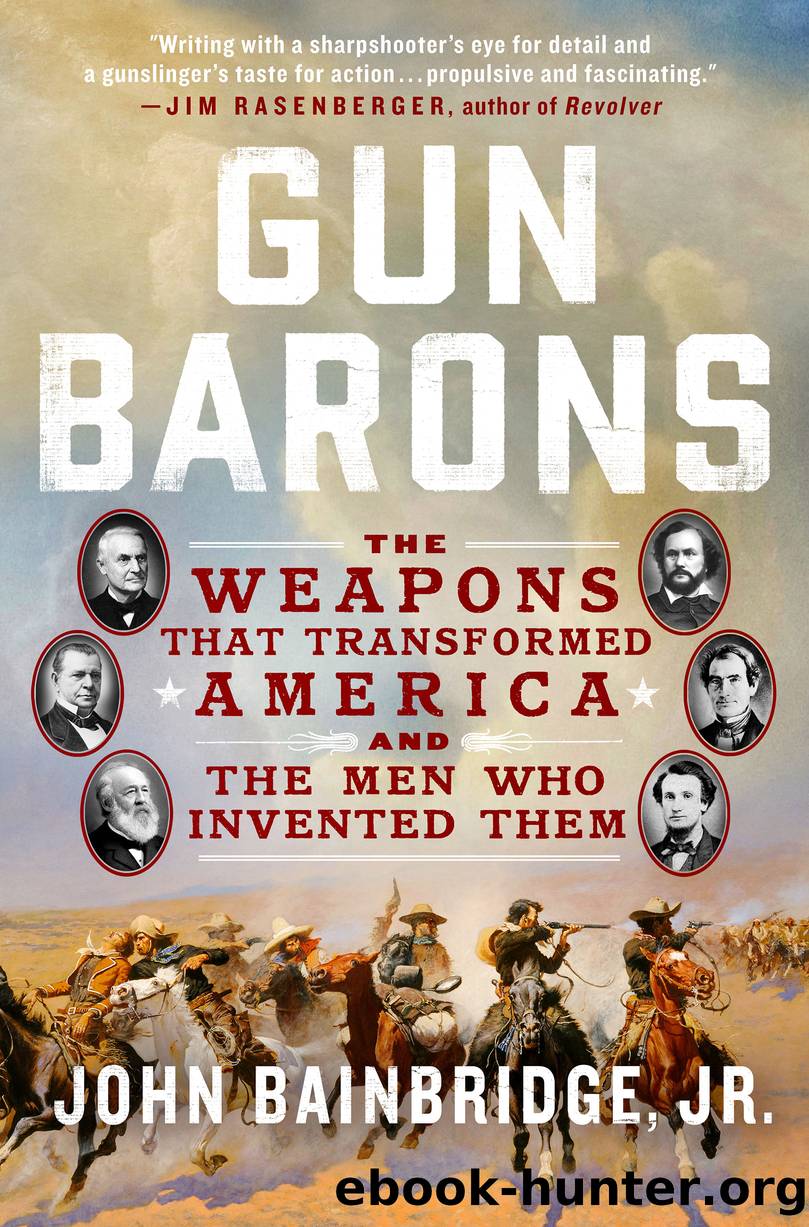Gun Barons by John Bainbridge Jr

Author:John Bainbridge, Jr.
Language: eng
Format: epub
Publisher: St. Martin's Publishing Group
* * *
When Lincoln visited Hartford, the Spencer rifle was nothing more than a dream reduced to paper accompanied by a model. The guns coming from the Colt and Sharps factories, on the other hand, were that and much more. Coltâs workforce had swelled from 150 employees making 9,000 pistols in 1850 to 369 employees turning out 45,000 guns plus machinery for sale in 1860. The Sharps factory, once associated with Robbins & Lawrence, didnât exist in 1850, but ten years later its 300 workers built 10,000 breech-loading rifles invented by Christian Sharps, who had worked closely with the Vermont firm to develop and make his guns in the early 1850s. The world of American arms making had come a long way since Samuel Colt launched his first revolver business in 1836. The old system of small makers (Eli Whitney was an exception) who contracted with the national armories they depended on was giving way to larger private concerns whose owners set themselves on a path to personal wealth. Private capital launched these businesses, and while they courted government contracts, they struck out on their own with designs they or those they employed came up with. They were a new breed who defended patents jealously, rushing into court to beat back the competition. Among them were builders of business empires.
Colt led the way. He had tried to get his revolving-cylinder patent extended even after it had expired by wooing powerful people he thought could do him some good, including legislators he favored with attention and gifts. Colt lost that battle, but his production of revolvers kept going strong. In 1860 Colt added a new revolver to his line, bigger than the Navy, smaller than the Dragoon, perfect for carrying in a hip holster. It would be called the 1860 Army and begin coming off his assembly line just in time for serious orders from a military engaged in all-out war. And why wouldnât Samuel Colt be a success even without his exclusive patent? He was now more than a man; he was a brand. More than a brand, he was a gun, his name increasingly synonymous with a revolving pistol. People moving west were encouraged to follow this advice from an 1859 handbook for cross-country travelers:
Every man who goes into the Indian country should be armed with a rifle and revolver, and he should never, either in camp or out of it, lose sight of them. When not on the march, they should be placed in such a position that they can be seized at an instantâs warning; and when moving about outside the camp, the revolver should invariably be worn in the belt, as the person does not know at what moment he may have use for it.
Download
This site does not store any files on its server. We only index and link to content provided by other sites. Please contact the content providers to delete copyright contents if any and email us, we'll remove relevant links or contents immediately.
| American National Standards Institute (ANSI) Publications | Architecture |
| History | Measurements |
| Patents & Inventions | Research |
Whiskies Galore by Ian Buxton(40558)
Introduction to Aircraft Design (Cambridge Aerospace Series) by John P. Fielding(32357)
Small Unmanned Fixed-wing Aircraft Design by Andrew J. Keane Andras Sobester James P. Scanlan & András Sóbester & James P. Scanlan(32154)
Craft Beer for the Homebrewer by Michael Agnew(17466)
Turbulence by E. J. Noyes(7066)
The Complete Stick Figure Physics Tutorials by Allen Sarah(6653)
Kaplan MCAT General Chemistry Review by Kaplan(6077)
The Thirst by Nesbo Jo(5809)
Bad Blood by John Carreyrou(5793)
Learning SQL by Alan Beaulieu(5438)
Weapons of Math Destruction by Cathy O'Neil(5062)
Man-made Catastrophes and Risk Information Concealment by Dmitry Chernov & Didier Sornette(4760)
iGen by Jean M. Twenge(4710)
Digital Minimalism by Cal Newport;(4593)
Life 3.0: Being Human in the Age of Artificial Intelligence by Tegmark Max(4529)
Audition by Ryu Murakami(4117)
Electronic Devices & Circuits by Jacob Millman & Christos C. Halkias(4057)
1,001 ASVAB Practice Questions For Dummies by Powers Rod(4051)
Pale Blue Dot by Carl Sagan(4026)
